
Alexander Heinle
Alex is a marketer at Zavvy. On this blog, he mainly shares insights gained from discussions with selected experts and from helping our customers set up and improve their onboarding or learning programs.

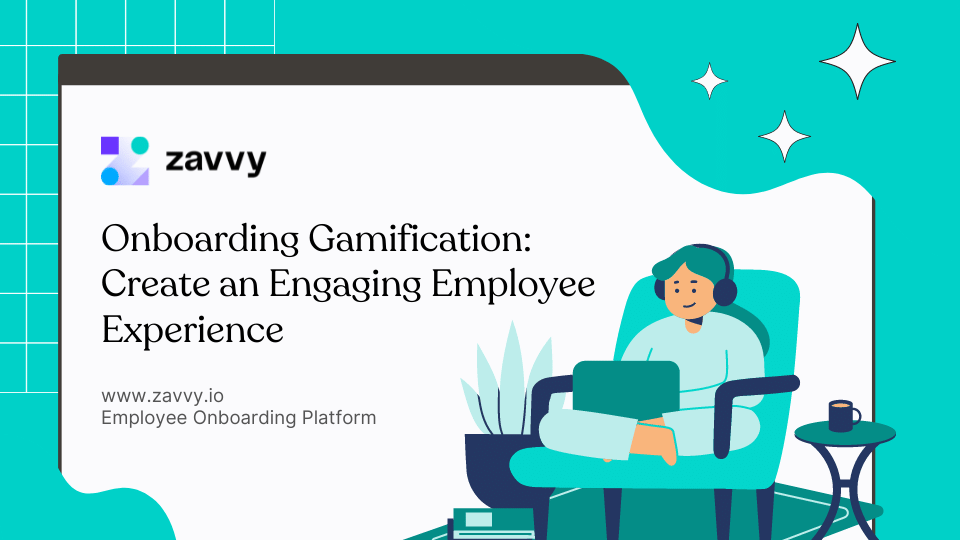
Imagine going to college for the first time. What were the questions in your head?
Will I feel welcomed?
Will I make friends?
Will there be seniors to guide me through?
How will the experience help in my career?
New employees are no different. They have similar questions and fears (which need to be addressed asap).
College students tend to stick around even if these questions go unanswered.
But the same cannot be said for employees: 52% of new employees in the US with tenures of 3 months or less are already looking to leave.
With the great resignation trends, it's now important (more than ever) to get onboarding right.
Welcoming new employees should not be a classic tale of boring presentations which demands coffee to survive. But a fun experience that also answers all their questions.
Cue onboarding gamification: a strategy designed to make your onboarding more engaging and fun.
But how do you gamify an employee onboarding process? And what are the benefits? This article will answer all of your questions.
Together with our curators, we have created a library of actionable digital marketing resources. Personalized to your team's needs.
Have you ever played football with friends?
It's so addictive. And you never wanna come back from the field.
There are no prizes for playing a thrilling match with friends on Sunday. Yet you keep scores and stay competitive. What keeps you in is probably the thrill of being outdoors and sharing experiences and competing with your friends. And the rush for being on the winning side.
That's what makes you hooked on the experience. Be it a hot sunny day or a rainy day.
Gamification means using gameplay mechanics for non-game applications to encourage specific behaviors and outcomes.
Gamification is based on people's psychological predisposition to engage in gaming. Therefore, it can be instrumental in encouraging people to perform chores perceived as boring.
In an employee onboarding setting, gamification means adding elements that make the new hire experience more fun, competitive, and engaging.
Think: filling in paperwork or going through compliance training.
But what is essential for gamification efforts in onboarding is the idea of engagement, story, autonomy, and meaning.
As highlighted by Karl M. Kapp says in his book, The Gamification of Learning and Instruction:
"Games give experiences meaning; they provide a set of boundaries within a 'safe' environment to explore, think and 'try things out.' Games provide motivation to succeed and reduce the sting of failure."
On its surface, gamification is "simply the use of game mechanics to make learning and instruction more fun."
In an onboarding setting, you might be tempted to see gamification as a shortcut to get your new hires to achieve specific learning goals:
That's where most companies go wrong, according to Kapp:
"Don't think of gamification as only the use of badges, rewards, and points; instead, think of the engaging elements of why people play games - it's not just for the points - it's for the sense of engagement, immediate feedback, feeling of accomplishment, and success of striving against a challenge and overcoming it.
Let's situate learners in authentic environments in which they can practice their skills and gain immediate feedback on progress and accomplishments, earn recognition for doing well, and feel satisfied for overcoming a challenge.
All of that sure beats the heck out of answering a multiple-choice question."
New hire onboarding gamification elements help create an engaging onboarding experience without compromising learning. Plus, it gives new hires a clear blueprint to get into work mode.
The most typical elements of gamification in onboarding are:
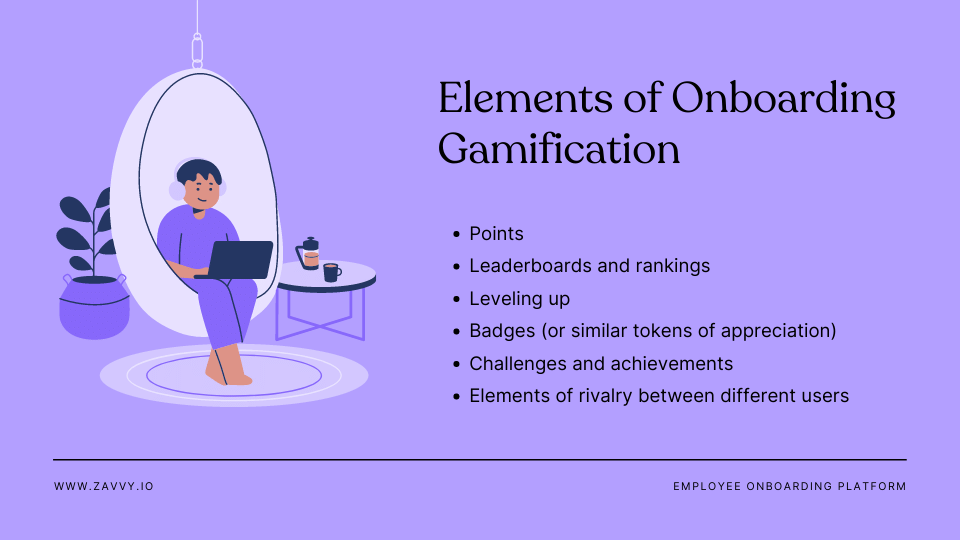
Conducting a proper employee onboarding has its advantages. However, adding gamification on top of it makes onboarding even more fun and further boosts the benefits.
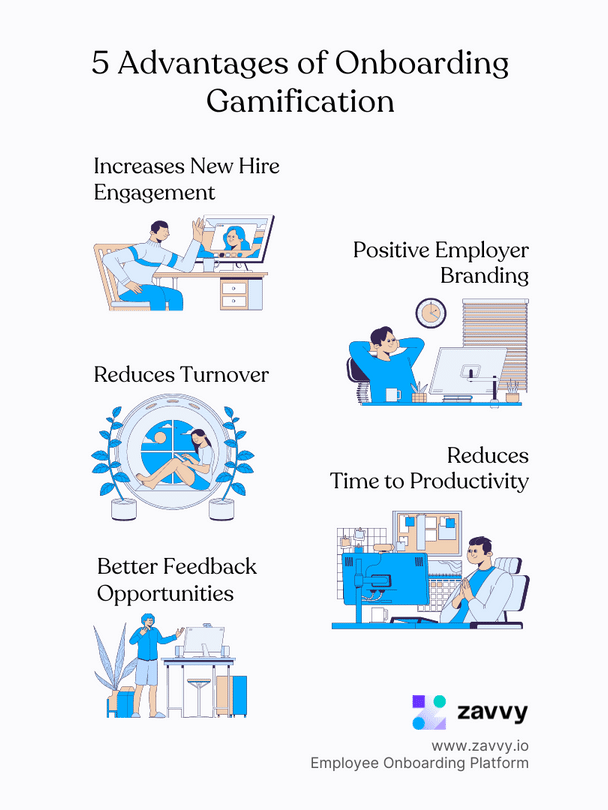
Maciek Kubiak, Head of People, PhotoAiD, shared a compelling use case for gamification:
"Each department at our company has a reading list. A few items are compulsory, but most are not. However, to have expertise in their respective department, our recruits are expected to finish the non-compulsory items eventually.
After adding gamification, 90% of new employees completed the whole departmental reading list. The count was around 55% before that."
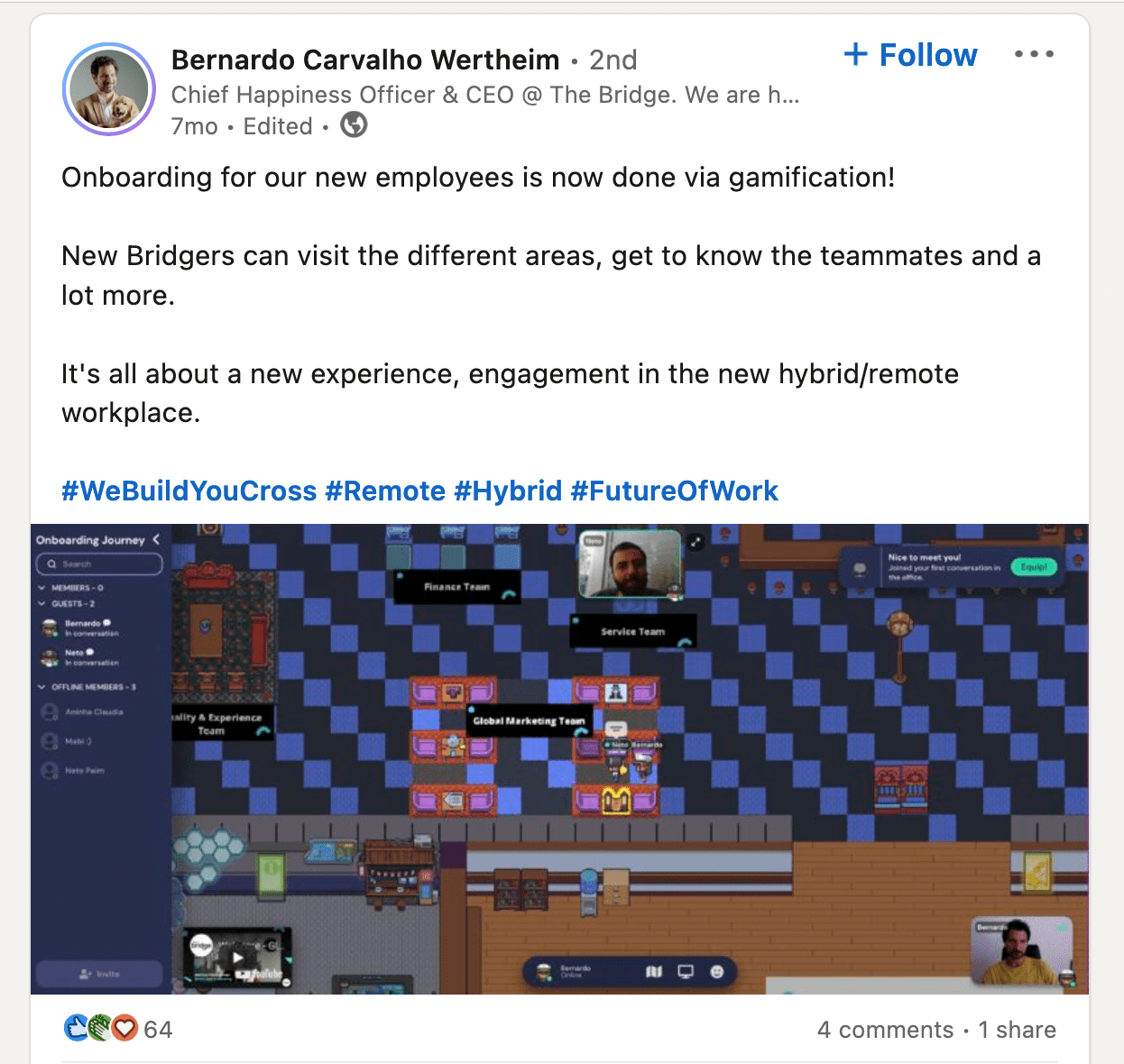
An onboarding training looking like an information encyclopedia is in no way supposed to be engaging. So, new hire training gamification adds an element of structure to your onboarding and increases engagement.
➡️ Are you still having a hard time increasing employee engagement? Then, take the shortcut and build your engagement action plan with our template.
Gamification increases engagement, and an engaged employee has fewer chances of leaving the company.
A Gallup study shows a business with high employee engagement experiences 43% less turnover.
Gamification engages new hires in a better way and stops them from ghosting your firm.
Gamification makes onboarding more enjoyable and speeds up learning and new hire acclimatization.
Using gamification will improve how you're structuring information and can help reduce new hires' confusion.
Overall, your recruits will become productive faster.
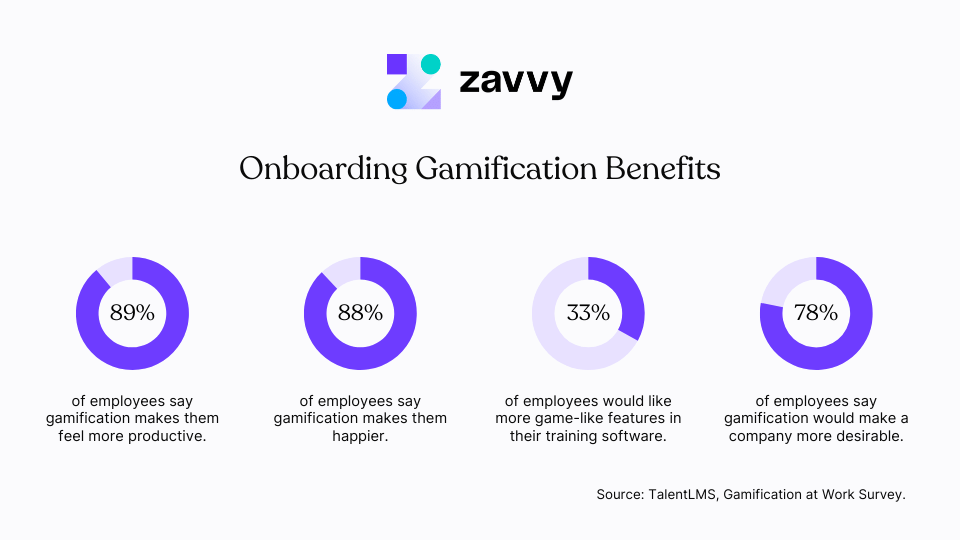
You do not get a second chance to create a first impression.
Starting the first day at work with a welcome email and a set of pdf(s) or ppt(s).
versus
Start the first day at work with an onboarding video that quickly tells new employees where they are.
The latter will always leave a better impression.
Tip: Add in gamification elements, and you present yourself as an employer that cares about creating fun and rewarding new beginnings at work.
Points, scores, and leaderboards are traditional onboarding gamification elements that show your employees how they perform in the game and how they compare with fellow players.
Do you know what this means? Score-keeping gives your employees instant feedback on their progress.
Tip: Is your newest sales team member falling behind the cold calling challenge? Keep an eye on the leaderboard and offer additional support to help them meet the challenge.
With onboarding gamification, the employees can use the feedback from challenges and quizzes to find areas for improvement. They won't have to wait until their supervisor 1:1 to find what areas to focus on.
Janani Kumar, a thought-leader in design-led innovation for the enterprise, says:
"Gamification is not the same as game design. It is carefully selecting elements we love about games, like a challenge, connection, competition, and feedback. And adding it to a non-game context to solve a problem."
At Zavvy, we break gamification into a simple equation.
Gamification = Connection + Interaction + Challenge
This equation led to the below 3-step guide to gamify an onboarding program.
Humans are born storytellers, which makes stories the best way to build a connection.
With story-based onboarding, you can use work-related storylines to deliver orientation-specific learning experiences. The best part about this strategy is that it is perfect for your hybrid workforce.
Can you look at your onboarding checklist and pinpoint which sections will be most engaging as stories?
This is what a sample onboarding checklist would look like:
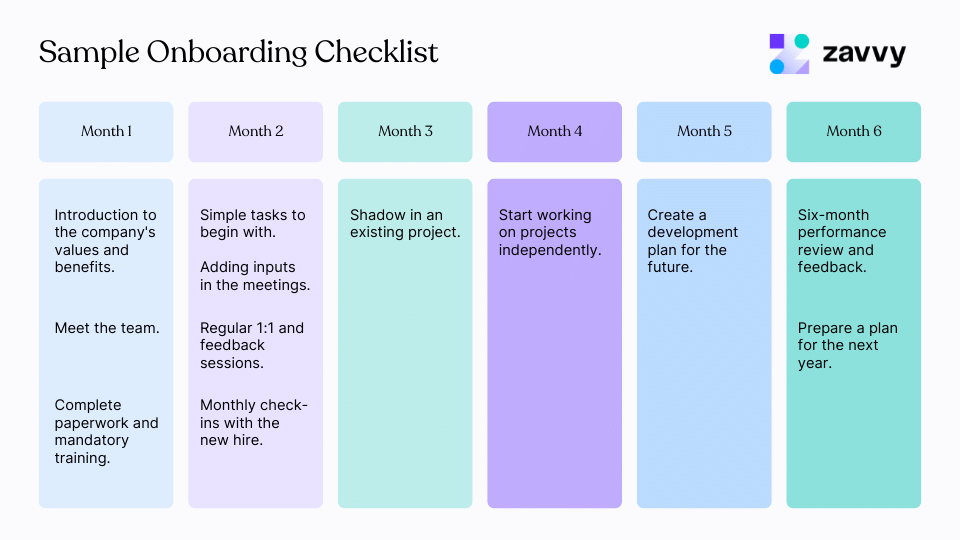
Month 1: Introduction to the company's values and benefits. Meet the team. Complete paperwork and mandatory training.
Month 2: Simple tasks to begin with and adding inputs in the meetings. Regular 1:1 and feedback sessions and a monthly check-in.
Month 3: Shadow in an existing project.
Month 4: Start working on projects independently.
Month 5: Create a development plan for the future.
Month 6: Six-month performance review and feedback. Prepare a plan for the next year.
➡️ Are you in need of a more comprehensive checklist? Say no more. Download our template below.
Mitch Chailland, President of Canal HR, says:
"Your professional role or persona is much like a character in a game. You have skills, a background, and a unique place in which you fit within your company's story."
See Deloitte's example below to see storytelling in action with their gamified onboarding for consultants.
Do not leave the player alone on a field. You can increase new hire socialization and trust by introducing a collaboration mechanic.
You can group new hires and teams and have them solve a role-specific challenge.
Tip: To boost fun, organize a regular trivia get-together where employees can learn fun facts about each other. Use an online quiz builder and include at least one fact about each of the employees, old and new. Interaction and engagement are guaranteed.
One thing we all enjoy about games is achieving the next milestone and seeing the scoreboard.
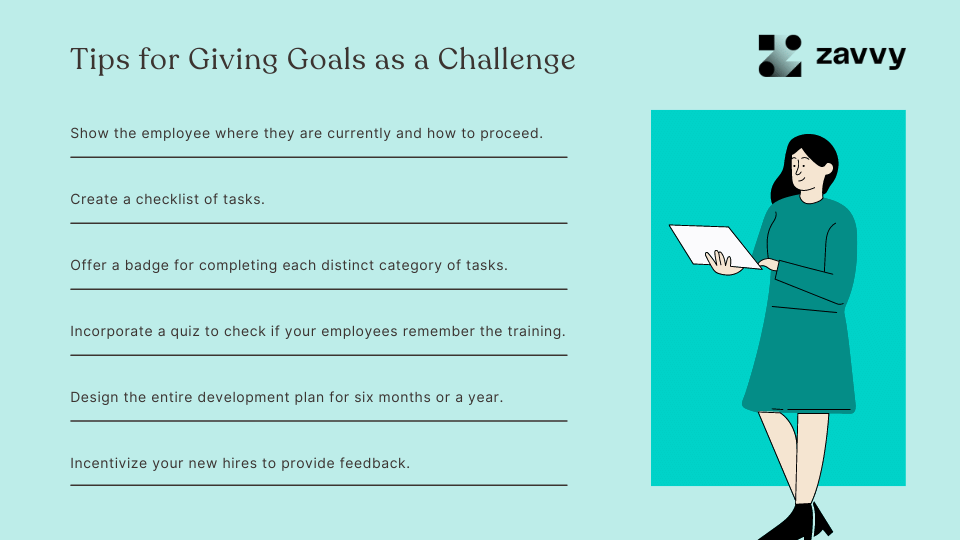
Tip #1: Show the employee where they are currently and how to proceed. Achieve this with progress bars. They are great motivators, increasing employee engagement and satisfaction.
Tip #2: You can also assign tasks. Checking a task off the checklist releases happy hormones.
Tip #3: Offer a badge for completing each distinct category of tasks. For example, offer a badge for completing all culture-related presentations, meetings, and assignments.
Tip #4: Incorporate a quiz to check if your employees remember the core of your new hire onboarding training.
Tip #5: You can also design the entire development plan for six months or a year as an exciting challenge.
Tip #6: Incentivize your new hires to provide feedback. You can offer a special badge for those that provide feedback and complete the onboarding survey.
Not all gamification efforts are equal. There is nothing intrinsic to gamification that makes it a guaranteed success.
Here are five significant ways in which gamification can go wrong.
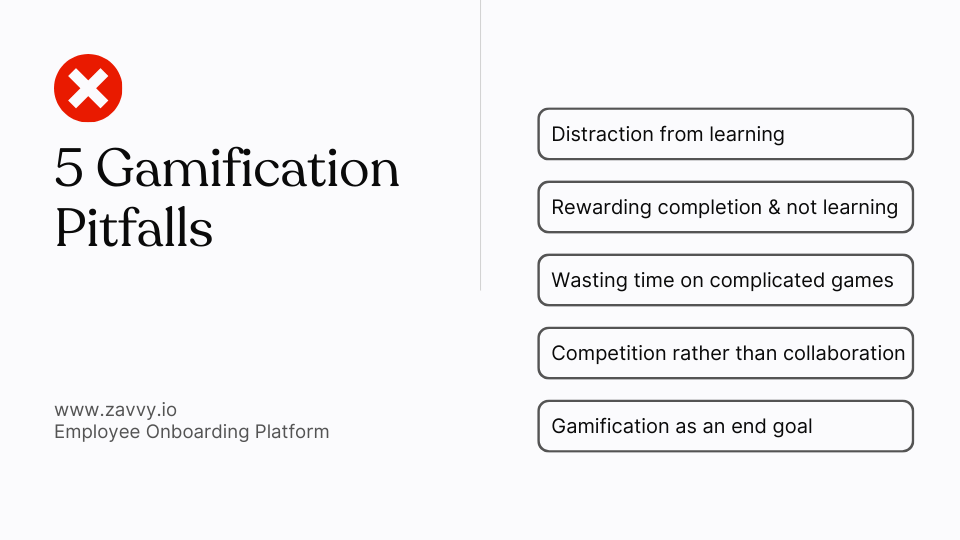
Learning any game takes time, often months to years. The purpose of gamification in onboarding is to assist learning processes and not hinder them.
Tip: Designing a program that looks awesome but needs an instruction manual defeats the purpose.
The progress bar will motivate your new hires to stay active until achiving a 100% score. But that might backfire.
Are your employees spending enough time on the tasks? Or are they just rushing through them to get the perfect completion score?
Tip: Adding many rewards with completion might make it even more attractive to complete the onboarding journeys in fast-track mode without learning from them.
It's easy to leave the expected track and start designing something super fancy. Imagine employees are catching Pokémon to move ahead. How amazing will the program look?
But gamification should simplify new employees' learning while keeping it entertaining.
Tip: The overemphasis on the design will only be a waste of time.
Our gamification equation prioritizes connection, interaction, and challenge over the competition.
Leaderboards are a familiar game mechanic that applies to the onboarding process.
Tip: While some competition is healthy, ensure you don't create rivalries. Nobody wants to see team sales holding a grudge against team customer success.
It would be a strategic error to implement gamification as an end goal just to keep up with industry trends.
After all, even if fun on paper, useless gamified tasks or actions can still contribute to employee disengagement and dissatisfaction.
New hires want to gain knowledge for performing faster and better. They don't want to waste their time on useless games and gimmicky tasks.
Tip: So ensure that you are intentional when introducing game elements in your onboarding strategy.
Deloitte took cues from pop culture and launched an onboarding game themed on the Zombie apocalypse.
The plot was interesting: The player (new hire) will have to find a cure to save humanity by making correct choices throughout the game.
Consulting skills like PowerPoint, Excel, and professionalism, previously taught in the classroom, were now discussed via the game. Learners found the gamified approach exciting, making it a huge hit.
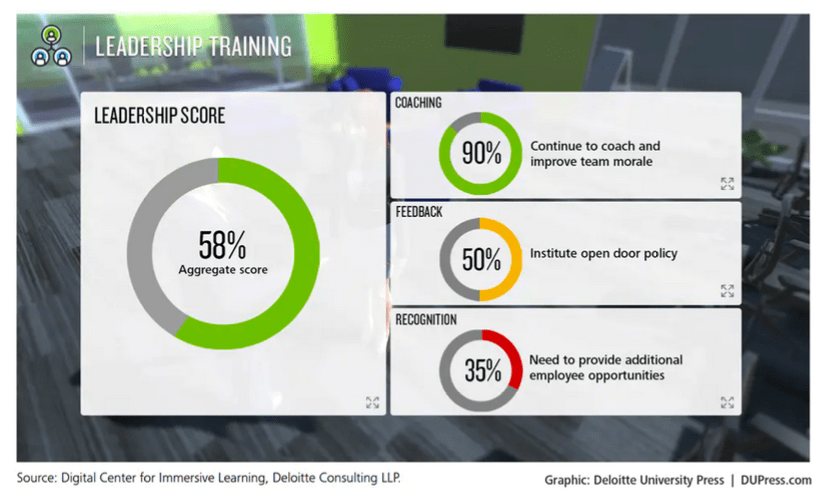
Ikea, the world's largest furniture retailer, thought instead of telling new hires about the company values, why not show them? So they used virtual reality(VR) for onboarding. With VR, new hires can experience the work environment and understand different job functions.
Bazaarvoice sends its new employees on a weeklong scavenger hunt with a list of over 60 tasks. From attending sales calls to taking colleagues for lunch, the list is wholesome.
➡️ Get inspired by 11 additional examples of the best employee onboarding experiences.
We looked at the DNA of gamification: Connection, Interaction, Challenge, and how to achieve these three. But there is a bonus for you. Here are five additional tips to make your onboarding gamified.
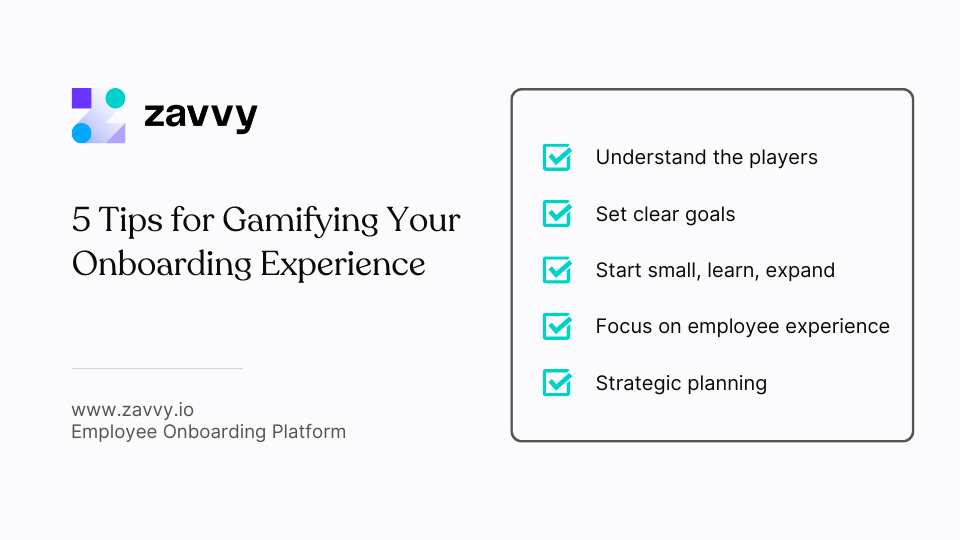
Different people have different motivations. It could be an immersive 3-D virtual office tour for someone. For others, it could be a short Zoom call with games. A few would like to flaunt a digital certificate on LinkedIn. But for someone, incentives would be more significant.
Understanding your employees and what excites and engages them will help you design a meaningful experience.
Find what goals you wish to achieve out of gamifying the onboarding experience. Common goals are:
These goals will help you design the process and assess if things are going right.
Gamifying the entire experience at once and, in the end, finding it doesn't suit your needs will waste precious resources.
So, start small. Find what's working and build on that.
We cannot stress this enough: gamification is as much about your goals as it is about employee experience.
Your employees have to find meaning in participating in gamified activities and tasks.
If they dread it as much as participating in a boring compliance presentation, you're doing something wrong.
View gamification as an add-on to an onboarding process that connects new employees with company culture and goals, frequent feedback, progress tracking, and achievements.
Lastly, less than a tip, this point is more of a prerequisite.
Doing gamification only because everyone else is doing it will not help.
If you're not strategic, gamification is not a magic formula for new employee engagement or productivity.
Instead, gamification should solve a problem for you or improve your onboarding process.
So before you even begin, do you have an onboarding strategy? Once that is done, it's time to answer the question of why gamification?
Professor and play theorist Brian Sutton-Smith rightly said: "The opposite of play is not work but depression."
So, is your onboarding program play or work? Save your employees from boring-to-death onboarding experiences.
Get an onboarding software that motivates action, makes the experience interactive, and sets the right tone from Day 1.
Get Zavvy today!
Book a free 30-minute demo now. Your employees deserve engaging and rewarding employee experiences.
Upskill your team every week with the best contents and personalized recommendations.

Imagine going to college for the first time. What were the questions in your head?
Will I feel welcomed?
Will I make friends?
Will there be seniors to guide me through?
How will the experience help in my career?
New employees are no different. They have similar questions and fears (which need to be addressed asap).
College students tend to stick around even if these questions go unanswered.
But the same cannot be said for employees: 52% of new employees in the US with tenures of 3 months or less are already looking to leave.
With the great resignation trends, it's now important (more than ever) to get onboarding right.
Welcoming new employees should not be a classic tale of boring presentations which demands coffee to survive. But a fun experience that also answers all their questions.
Cue onboarding gamification: a strategy designed to make your onboarding more engaging and fun.
But how do you gamify an employee onboarding process? And what are the benefits? This article will answer all of your questions.
Get a demo!
We'll be happy to show you around and answer all your questions.
Trusted by innovative companies



We'll be happy to show you around, answer your questions, or arrange a free trial.
Erhalten Sie eine kostenlose Demo unserer Onboarding-Software.
Vertraut von



Your Training & Development Strategy - Solved in 1 Tool.
Trusted by innovative companies



We'll be happy to show you around, answer your questions, or arrange a free trial.
Learn how Zavvy helps you drive performance, development, and engagement.
Trusted by innovative companies



We'll be happy to show you around, answer your questions, or arrange a free trial.
We'll be happy to show you around and answer all your questions.
Trusted by innovative companies



We'll be happy to show you around, answer your questions, or arrange a free trial.
Gerne zeigen wir Ihnen ganz unverbindlich unsere Plattform im Detail.
Vertraut von modernen Unternehmen



Get a demo!
We'll be happy to show you around and answer all your questions.
Trusted by innovative companies



We'll be happy to show you around, answer your questions, or arrange a free trial.
Erhalten Sie eine kostenlose Demo unserer Software für Mitarbeiterenwicklung und Training.
Moderne Unternehmen
setzen auf Zavvy


